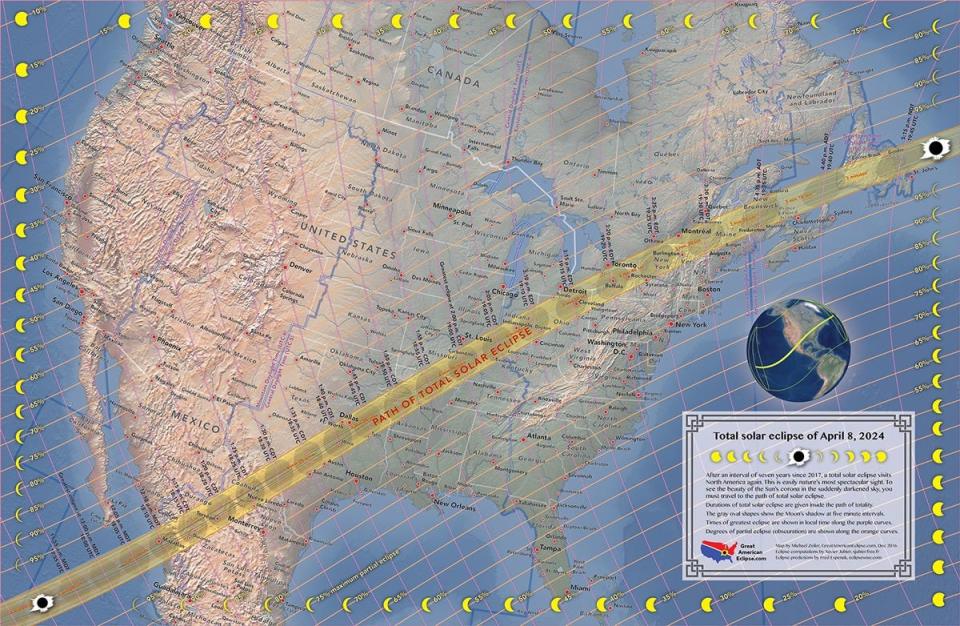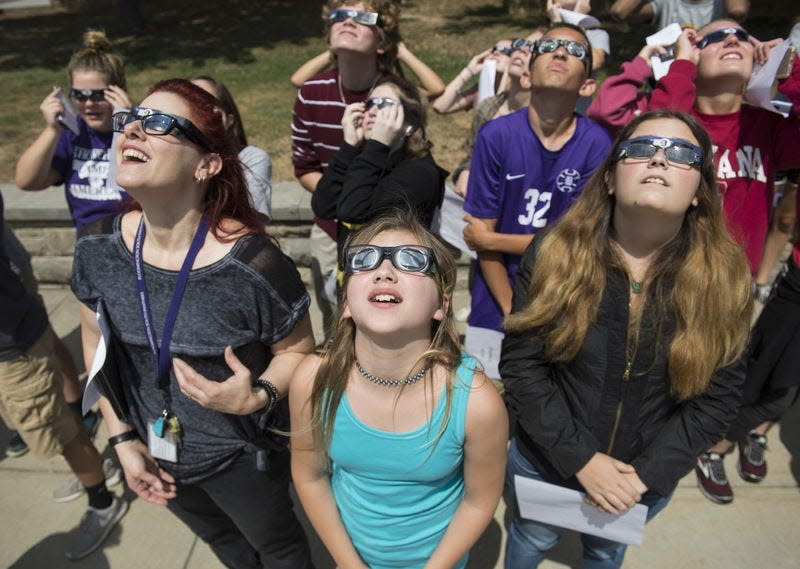Bloomington preparing for thousands to visit for total solar eclipse in April 2024
How do you plan for between 40,000 and 100,000-plus more people to congregate in the Bloomington area?
That's the task Kirk White, vice provost for external relations and assistant vice president for strategic partnerships at Indiana University, and Mike McAfee, executive director of VisitBloomington, are spearheading as they look to April 8, 2024.
How long will the 2024 solar eclipse last in Bloomington?
What makes April 8, 2024, special is a total solar eclipse that will have a larger path than most eclipses, including the one on Aug. 21, 2017, and will viewable by more people as it crosses from Mexico into Texas and across the U.S. to Maine and into Canada. Bloomington will have one of the longest times of total darkness — 4 minutes and 2 seconds — beginning at 3:04 p.m.
"It's like a super eclipse," McAfee said, adding that officials are planning for visitors to spend a day, a couple hours or stop along highways to witness the eclipse.
Get your tickets: What to know about Here Come the Mummies at Brown County Music Center
"The major highways will become parking lots," White said, predicting people will stop their vehicles to watch the eclipse. "Then they are going to want to leave, and we have to be ready."
What are the odds of it being cloudy in Indiana during the 2024 eclipse?
April weather in Indiana means there is a chance clouds will obscure the view. White said it's a 50/50 chance of cloudy skies on an April day, but as long as the sun is visible, huge crowds of people are expected, and that means preparing everything from public safety and transportation to ensuring there are enough restaurants and restrooms for visitors and residents.
A VisitBloomington web page has been launched to help inform residents, potential visitors and business owners about the solar eclipse and what will be happening. The site also may provide details on April 8 letting people know where to find various activities, space to watch or help from first responders.

What do officials expect during the total solar eclipse?
Some of the areas White and McAfee are addressing include the educational and scientific focus, with experts from Indiana University, WonderLab and other agencies helping gear up for what will be happening and to share the history of previous eclipses.
"I expect to see the classes (at Indiana University) empty into the green spaces," White said, adding that IU and Bloomington have "vast physical spaces," from parks to stadiums where people may gather, perhaps even at Memorial Stadium. The hope is that science faculty and guest speakers can explain what's happening and its relevance to people who are present and possibly through Zoom or other social media. Indiana University also has a web page, eclipse.indiana.edu, that will have more information added as the event draws near.
A portion of the Monroe County Fairgrounds already has been reserved for camping during the total eclipse, McAfee said.
There will be centralized locations for organized viewing to minimize confusion and provide a safe and positive experience, McAfee said. Those include area state parks, other properties, including Lake Monroe, and city and county parks. Many area schools are expected to take the day off, which will allow people to assemble at their stadiums and tracks.
Should highways become parking lots during the eclipse, as White mentioned, that could cause problems for emergency personnel. White said his goal is to see the eclipse as "a good way to test the systems" for emergency management in Bloomington, Monroe County and surrounding areas. "We're going to put together the right teams to make sure we're prepared for this."
What causes a solar eclipse?
A solar eclipse happens when the moon passes between the Earth and the sun. Bloomington was in the path of a partial solar eclipse on Aug. 21, 2017. Portions of Illinois, Kentucky and Missouri experienced a total solar eclipse that time. Next year, the total solar eclipse will start in Texas and go through Maine and into Canada.
An interesting fact provided by NASA is that in 2017, the moon's shadow was seen by astronauts in the space station, which crossed the path of the eclipse three times during its orbit above the continental United States.
Which Indiana cities are in the path of the total solar eclipse?

The first city where totality will begin, at 3:01 p.m. EDT, is Mount Vernon, which will be totally dark for 3 minutes, 30 seconds. Then Princeton and Evansville, followed at 3:02:52 p.m. by Vincennes, the Hoosier city that will have the longest time of darkness (4 minutes, 5 seconds). Next up, in order, are: Washington at 3:03:27 p.m., Sullivan at 3:03:35 p.m., Linton at 3:30:47 p.m. (for 4 minutes, 2 seconds), Jasper at 3:03:56 p.m., Santa Claus at 3:04:23 p.m., Terre Haute at 3:04:23 p.m., French Lick at 3:04:36, West Baden Springs at 3:04:36 p.m., Brazil at 3:04:42 p.m., Bedford at 3:04:48 p.m., Bloomington at 3:04:52 p.m., Martinsville at 3:05:16 p.m., Franklin at 3:05:51 p.m., Greenwood at 3:05:55 p.m., Columbus at 3:05:57 p.m., Salem at 3:06:00 p.m., Indianapolis at 3:06:04 p.m., Seymour at 3:06:05 p.m., Shelbyville at 3:06:19 p.m., Carmel at 3:06:29 p.m., Fishers at 3:06:32 p.m., Greensburg at 3:06:49 p.m., Scottsburg at 3:07:07 p.m., Anderson at 3:07:08 p.m., New Castle at 3:07:16 p.m., Connersville at 3:07:29 p.m., Muncie at 3:07:35 p.m., Richmond at 3:07:59 p.m., Marion at 3:08:17 p.m., Portland at 3:08:24 p.m. and Decatur at 3:09:18 p.m.

How can you safely watch the eclipse?
Most days people don't look directly at the sun, but during the solar eclipse, it's possible to look at the sun too long, damaging your eyes. Special glasses or a viewer are needed to look at the eclipse except during totality. The glasses or viewers need to meet the ISO 12312-2 international standard and be free from any holes, scratches or dents. Homemade filters and ordinary sunglasses will not offer adequate protection.
When is the next total solar eclipse crossing the United States?
The next total solar eclipse will be Aug. 25, 2044, and will be visible in parts of Montana and North Dakota.
Where can you find more information about total solar eclipses?
For information about Bloomington, go to VisitBloomington's page at www.visitbloomington.com/2024-solar-eclipse/, Indiana University's page at eclipse.indiana.edu/ or WonderLab's page at wonderlab.org/2024-solar-eclipse/. For other sites, check out nationaleclipse.com, NASA's site at https://go.nasa.gov/3K3jdwT as well as whenisthenexteclipse.com and eclipse2024.org. The Indiana Department of Natural Resources also has a web page under construction at https://bit.ly/3lZGqrC.
Contact Carol Kugler at ckugler@heraldt.com, 812-331-4359 or @ckugler on Twitter.
This article originally appeared on The Herald-Times: Bloomington, Indiana in path of total solar eclipse on April 8, 2024

